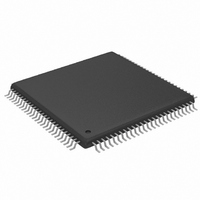MAX2038CCQ+ Maxim Integrated Products, MAX2038CCQ+ Datasheet - Page 19

MAX2038CCQ+
Manufacturer Part Number
MAX2038CCQ+
Description
IC VGA W/OCTAL MIXER 8CH 100TQFP
Manufacturer
Maxim Integrated Products
Type
Variable Gain Amplifierr
Datasheet
1.MAX2038CCQT.pdf
(24 pages)
Specifications of MAX2038CCQ+
Applications
Medical Ultrasound Imaging, Sonar
Mounting Type
Surface Mount
Package / Case
100-TQFP Exposed Pad, 100-eTQFP, 100-HTQFP, 100-VQFP
Lead Free Status / RoHS Status
Lead free / RoHS Compliant
The mode select response time is the time that the
device takes to switch between CW and VGA modes.
One possible approach to interfacing the CW outputs to
an instrumentation amplifier used to drive an ADC is
shown in Figure 2. In this implementation, there are four
large-value (in the range of 470nF to 1µF) capacitors
between each of the CW_IOUT+, CW_IOUT-,
CW_QOUT+, CW_QOUT- outputs and the circuitry they
are driving. The output of the CW mixer usually drives
the input of an instrumentation amplifier made up of op
amps whose input impedance is set by common-mode
setting resistors.
There are clearly both a highpass corner and a lowpass
corner present in this output network. The lowpass cor-
ner is set primarily by the 115Ω mixer pullup resistors,
the series 50Ω resistors, and the shunt 0.022µF capaci-
tor. This lowpass corner is used to filter a combination
of LO leakage and upper sideband. The highpass cor-
ner, however, is of a larger concern due to the fact that
it is dominated by the combination of a 1µF DC-block-
ing capacitor and the pair of shunt 31.6kΩ resistors.
If drawn, the simplified dominant highpass network
would look like Figure 3.
Figure 2. Typical Example of a CW Mixer’s Output Circuit
Figure 3. Simplified Circuit of Highpass Pole
115Ω
CW_IOUT+
CW_IOUT-
115Ω
Applications Information
50Ω
______________________________________________________________________________________
Mode Select Response Time
1μF
0.022μF
31.6kΩ
31.6kΩ
1μF
1μF
31.6kΩ
Ultrasound VGA Integrated
The highpass pole in this case is at f
~ 5Hz. Note that this low highpass corner frequency is
required in order to filter the downconverted clutter tone,
which appears at DC, without interfering with CWD imag-
ing at frequencies as low as 400Hz. For example, if one
wanted to use CWD down to 400Hz, then a good choice
for the highpass pole would be at least a decade below
this (< 40Hz) as not to incur rolloff due to pole. Remember,
if the highpass pole is put at 400Hz, the response is 3dB
down at that corner frequency. The placement of the high-
pass pole at 5Hz in the above example is between the DC
and 40Hz limitations just discussed.
The bottom line is that any reasonably sized DC block
between the output of the mixer and the instrumentation
amplifier will pose a significant time constant that slows
the mode select switching speed.
An alternative solution to the approach in Figure 2,
which enables faster mode select response time, is
shown in Figure 4.
In Figure 4, the outputs of the CWD mixers are DC-
coupled into the inputs of the instrumentation ampli-
fiers. Therefore, the op amps must be able to accom-
modate the full compliance range of the mixer outputs,
which is a maximum of 11V when the mixers are dis-
abled, down to the 5V supply of the MAX2038 when the
mixers are enabled. The op amps can be powered from
11V for the high rail and 5V for the low rail, requiring a
6V op amp.
Figure 4. Improved Mode Select Response Time Achieved with
DC-Coupled Input to Instrumentation Amplifier
with CW Octal Mixer
+11V
+5V
P
= 1/(2 x pi x RC)
19












